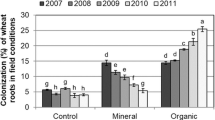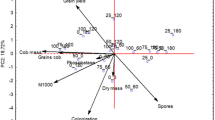Abstract
A field study was carried out on a six-year-old on-farm field trial during long-rains season (April–August) 2003 to investigate the effect of improved fallow systems and phosphorus application on arbuscular mycorrhiza fungi (AMF) symbiosis in maize. The trial comprised of maize rotated with a fast growing leguminous Crotalaria grahamiana fallow and a non-leguminous Tithonia diversifolia fallow for 3 years followed by continuous maize. The experiment was randomized complete block design with three cropping (continuous maize, Crotalaria fallow and Tithonia fallow) systems and two phosphorus levels (0 and 50 kg P/ha). AMF colonization in maize roots, maize yield and macro-nutrients uptake were recorded. Phosphorus applications improved (P < 0.05) early (<8 weeks old maize) AMF colonization, nutrient uptake and maize yield in improved fallow systems. Greater differences due to phosphorus application were noted in maize in Tithonia fallow than in Crotalaria fallow. Following phosphorus application, a positive relationship existed between early AMF colonization and maize yield (r = 0.38), and phosphorus and nitrogen uptake (r = 0.40 and r = 0.43, respectively), demonstrating the importance of phosphorus fertilization in enhancing low-input technologies (improved fallows systems) in phosphorus deficient and acidic soils of western Kenya.




Similar content being viewed by others
References
Allison VJ, Goldberg DE (2002) Species-level versus community-level patterns of mycorrhizal dependence on phosphorus: an example of Simpson’s paradox. Funct Ecol 16:346–352
Bolan NS, Robson AD, Barrow NJ (1984) Increasing phosphorus supply can increase the infection of plant roots by vesicular-arbuscular mycorrhizal fungi. Soil Biol Biochem 16:419–420
Borie F, Redel Y, Rubio R, Rouanet (2002) Interactions between crop residues application and mycorrhizal developments and some soil-root interface properties and mineral acquisition by plants in an acidic soil. Biol Fertil Soils 36:151–160
Buerkert A, Bationo A, Piepho HP (2001) Efficient phosphorus application strategies for increased crop production in sub-Saharan West Africa. Field Crops Res 72:1–15
Bünemann EK, Bossio DA, Smithson PC, Frossard E, Oberson A (2004a) Microbial community composition and substrate use in a highly weathered soil as affected by crop rotation and P fertilization. Soil Biol Biochem 36:889–901
Bünemann EK, Smithson PC, Jama B, Frossard E, Oberson A (2004b) Maize productivity and nutrient dynamics in maize-fallow rotations in western Kenya. Plant Soil 264:195–208
Bünemann EK, Steinebrunner F, Smithson PC, Frossard E, Oberson A (2004c) Phosphorus dynamics in a highly weathered soil as revealed by isotopic labeling techniques. Soil Sci Soc Am J 68:1645–1655
Buresh RJ (1999) Agroforestry strategies for increasing the efficiency of phosphorus use in tropical uplands. Agrofor Forum 9(4):8–13
Cardoso IM, Kuyper TW (2006) Mycorrhizas and tropical soil fertility. Agric Ecosyst Environ 116:72–84
Cardoso IM, Boddington C, Janssen BH, Oenema O, Kuyper TW (2006) Differential access to phosphorus pools of an oxisol by mycorrhizal and non-mycorrhizal maize. Commun Soil Sci Plant Anal 37:1–15
Evans DG, Miller MH (1998) Vesicular-arbuscular mycorrhizas and the soil-induced reduction of nutrient absorption in maize. I. Causal relations. New Phytol 110:67–74
García IV, Mendoza RE (2007) Arbuscular mycorrhizal fungi and plant symbiosis in a saline-sodic soil. Mycorrhiza 17:167–174
Gathumbi SM, Cadisch G, Giller KE (2002) 15N natural abundance as a tool for assessing N2-fixation of herbaceous, shrub and tree legumes in improved fallows. Soil Biol Biochem 34:1059–1071
Gavito ME, Miller MH (1998) Early phosphorus nutrition, mycorrhizae development, dry matter and partitioning and yield of maize. Plant Soil 199:177–186
George E, Marschner H, Jakobsen I (1995) Role of arbuscular mycorrhizal fungi in uptake of phosphorus and nitrogen from soil. Crit Rev Biotechnol 15:257–270
Gichuru MP, Bationo A, Bekundu MA, Goma HC, Mafongonya PL, Mugadi D, Murwira H, Nendwa SM, Nyathi P, Swift MJ (2003) Soil fertility management in Africa: regional perspective. Academy Science publishers, Nairobi, 322 pp
Harteminkv AE, Buresh RJ, Jama B, Janssen BH (1996) Soil nitrate and water dynamics in Sesbania fallows, weed fallows, and maize. Soil Sci Soc Am J 60:568–574
ICRAF (2000) Laboratory working manual. Plant and soil routine analysis of elements. World Agroforestry Centre, Nairobi
Jaetzold R, Schmidt H (1982) Farm management handbook of Kenya, vol II. Natural conditions and farm management information. Part A: West Kenya. Ministry of Agriculture, Kenya, in cooperation with the German Agricultural Team (GAT) of the German Agency for Technical Cooperation (GTZ), Kenya, 397 pp
Jama B, Swinkels RA, Buresh RJ (1997) Agronomic and economic evaluation of organic and inorganic sources of phosphorus in Western Kenya. Agron J 89(4):597–604
Kahiluoto H, Ketoja E, Vestberg M, Saarela I (2001) Promotion of AM utilization through reduced P fertilization 2. Field studies. Plant Soil 231:65–79
Karasawa T, Arihara J, Kasahara Y (2000) Effects of previous cropping on arbuscular mycorrhizal formation on growth of maize under various soil moisture conditions. Soil Sci Plant Nutr 46:53–60
Karasawa T, Kasahara Y, Takebe M (2001) Variable response of growth and arbuscular mycorrhizal colonization of maize plants to preceding crops in various types of soil. Biol Fertil Soils 33:286–293
Koide RT (2000) Functional complementarity in the arbuscular mycorrhizal symbiosis. New Phytol 147:233–235
Li H, Smith SE, Holloway RE, Zhu Y, Smith FA (2006) Arbuscular mycorrhizal fungi contribute to phosphorus uptake by wheat grown in a phosphorus-fixing soil even in the absence of positive growth responses. New Phytol 172:536–543
Maroko JB, Buresh RJ, Smithson PC (1999) Soil phosphorus Institute, in unfertilized fallow-maize systems on two tropical soils. Soil Sci Soc Am J 63:320–326
Mason P, Ingleby K (1998) Mycorrhizae working manual. ITP, Scotland
Mathimaran N, Ruh R, Jama B, Verchot L, Frossard E, Jansa J (2007) Impact of agricultural management on arbuscular mycorrhizal fungal communities in Kenyan ferralsol. Agric Ecosyst Environ 119:22–32
McGonigle TP, Evans DG, Miller MH, Fairchild GL, Swan JA (1990) A new method which gives an objective measure of colonization and phosphorus absorption by maize in growth chamber and field experiments. New Phytol 116:629–636
Mekonnen K, Buresh RJ, Jama B (1997) Root and inorganic nitrogen distributions in Sesbania fallow, natural fallow and maize fields. Plant Soil 188:319–327
Mendoza RE, Pagani E (1997) Influence of phosphorus nutrition on mycorrhizal growth response and morphology of mycorrhizae in Lotus tenuis. J Plant Nutr 20:625–639
Miller MH (2000) Arbuscular mycorrhizae and the phosphorus nutrition of maize: a review of Guelph studies. Can J Plant Sci 80:47–52
Miller M, Mcgonigle T, Addy HP (1995) Functional ecology of vesicular arbuscular mycorrhizas as influenced by phosphate fertilization and tillage in agricultural ecosystems. Crit Rev Biotechonol 15:241–255
Morton JB (1988) Taxonomy of VA mycorrhizal fungi: classification, nomenclature, and identification. Mycotaxonomy 32:267–324
Nziguheba G, Palm CA, Buresh RJ, Smithson PC (1998) Soil phosphorus fractions and sorption as affected by organic and inorganic sources. Plant Soil 198:159–168
Okalebo JR, Gathua KW, Woomer PL (2002) Laboratory methods of soil and plant analysis working manual, 2nd edn. TSBF, Nairobi
Picone C (2002) Managing mycorrhizae for sustainable agriculture in the tropics. In: Vandermeer JH (ed) Tropical agroecosystems. CRC, Boca Raton, pp 95–132
Sanchez PA (1999) Improved fallows come of age in the tropics. Agrofor Syst 47:3–12
Sanchez PA, Shepherd KD, Soule MJ, Place FM, Mukwunye AU, Bursch RJ, Kwesiga FR, Izac A-MN, Ndiritu CG, Woomer PL (1997) Soil fertility replenishment in Africa: an investment in natural resource capital. In: Bursch RJ, Sanchez PA, Calhoon F (eds) Replenishing soil fertility in Africa. Soil science society of America special publication No. 51. Madison, WI, pp 1–46
Shepherd KD, Ohlsson E, Okalebo JR, Ndufa JK (1996) Potential impact of agroforestry on soil nutrient balance at the farm scales in East Africa Highland. Fertil Resour 44:87–99
Sieverding E (1990) Ecology of VAM fungi in tropical agrosystems. Agric Ecosyst Environ 29:369–390
Singer JW, Cox WJ (1998) Corn growth and yield under different rotation, tillage and management systems. Crop Sci 38:996–1003
Smithson PC, Giller KE (2002) Appropriate farm management practices for alleviating N and P deficiencies in low-nutrient soils of the tropics. Plant Soil 245:169–180
Thompson JP (1991) Improving the mycorrhizal condition of the soil through cultural practices and effects on growth and phosphorus uptake by plants. In: Johansen (ed) Phosphorus nutrition of grain legumes in the semi-arid tropics. ICRISAT, Patancheru, pp 117–138
Thompson JP (1994) What is the potential for management of mycorrhizas in agriculture? In: Robison AD, Abbott LK, Malaczuk N (eds) Management of mycorrhizae in agriculture, horticulture and forestry. Kluwer, The Netherlands, pp 191–200
Treseder KK, Allen MF (2002) Direct N and P limitation of arbuscular mycorrhizal fungi: a model and field test. New Phytol 155:507–515
Trouvelot A, Kough JL, Gianinazzi-Pearson (1986) Mesure du taux de mycorhization VA d’un syste’me radivulaire. Recherche de me’thodes d’estimation ayant une significantion fonctionnelle. In: Gianinazzi-Pearson V, Gianinazzi S (eds) Physiological and genetic aspects of mycorrhizae. INRA, Paris, pp 217–221
Weng L, Van Riemsdijk WH, Hiemstra T (2008) Humic nanoparticles at the oxide–water interface: interactions with phosphate ion adsorption. Environ Sci Technol 42(23):8747–8752
Acknowledgments
The financial support for this study was provided by the ETH Zurich, secured through its collaboration with ICRAF. We wish thank the technical assistance from staff, colleagues and friends from the International Centre for Research in Agroforestry (ICRAF), Moi University, Kenya Forestry Research Institute (KEFRI), ETH, and National Museums of Kenya (NMK). In particular, Dr. Joyce Jefwa (NMK) for technical advice during the study, Milton (KEFRI) who assisted in generating AMF data and Mathimaran (ETH) for assisting in nutrient analysis of maize samples. We are also grateful to Richard Coe (ICRAF) for guiding in data analysis, and Omondi and his family for permission to use their farm. Lastly we are grateful to Dr. Muchane Muchai (NMK) for critically commenting on earlier version of the manuscript.
Author information
Authors and Affiliations
Corresponding author
Rights and permissions
About this article
Cite this article
Muchane, M.N., Jama, B., Othieno, C. et al. Influence of improved fallow systems and phosphorus application on arbuscular mycorrhizal fungi symbiosis in maize grown in western Kenya. Agroforest Syst 78, 139–150 (2010). https://doi.org/10.1007/s10457-009-9249-3
Received:
Accepted:
Published:
Issue Date:
DOI: https://doi.org/10.1007/s10457-009-9249-3




